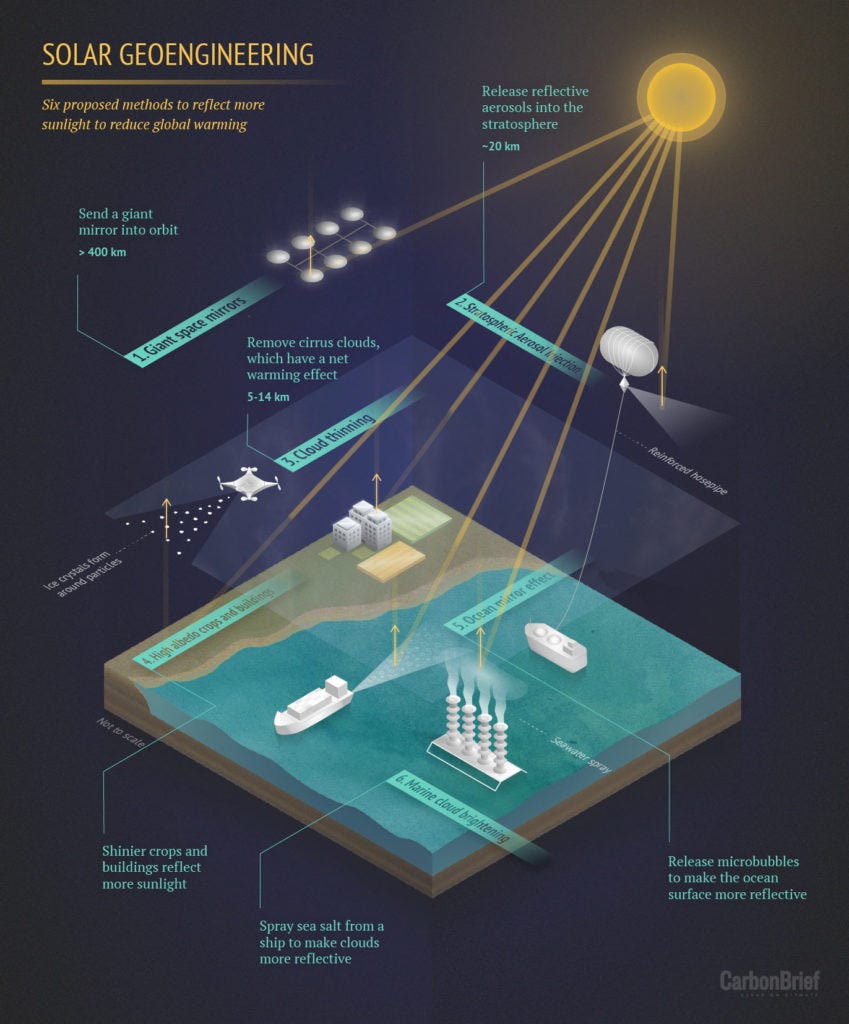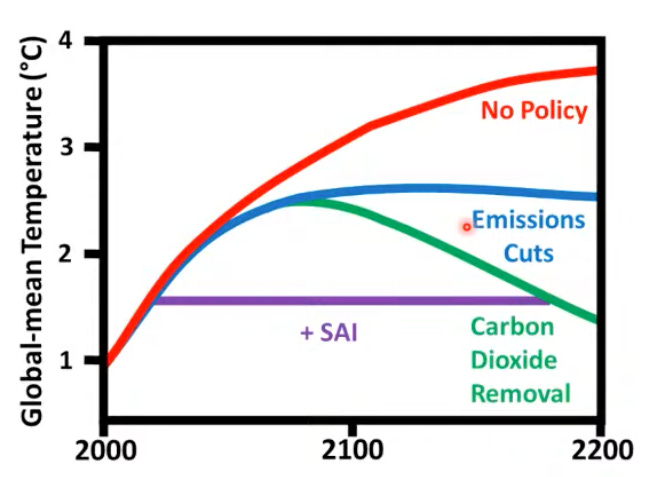Aim high (part 2)
Or how I learned to become (kind of) excited about geoengineering
Is summer over? It may feel that way as the holidays begin to fade in memory but for many parts of the world, and thoughts of a cooling autumn (or warming spring if you’re southern hemisphere) begin. But you wouldn’t know it from this (China), this (Australia) or this (Iran).
As these types of headlines because increasingly common, and extreme heat transmits into loss productivity, deaths, failed crops, infrastructure damage, etc. that begin to harm vested economic and political interests, the clamour for solutions will get louder. Political solutions may not be always what is best for those most impacted, or for the long-run, but in times of crisis leaders often want to reach for simple, cheap, easy-to-explain, and photogenic “silver bullets.”
That’s where solutions like cloud seeding, which I laid out in the previous post, and geoengineering can be enticing to policymakers, investors and solutions providers. The topic has garnered some more attention in the past 12 months, not all of it positive, so it’s worth walking through the technology and the so-what before coming down on where this fits within the climate security toolkit.
What is geoengineering and what’s different
Geoengineering is a “deliberate, large-scale manipulation of climate.” Media reporting tends to use this term to refer to a specific kind of engineering, solar radiation management (SRM), or manmade efforts to reflect more sunlight back into space than is absorbed by the ground or atmosphere.
It’s important to note that geoengineering and SRM are not synonymous - other forms of geoengineering exist to remove greenhouse gases from the atmosphere e.g. direct air capture and biochar technologies. And neither are cloud-seeding and geoengineering, despite connotations of doing something with spraying particles high in the air. Cloud seeding is focused on precipitation rather than reflecting sunlight or reducing Earth’s albedo, and is local versus regional or global. As such, they are different tools for managing climate security issues - and should be reflected in policy, tech and risk management stacks.
With existing technology, SRM takes a few potential forms: stratospheric aerosol injection (SAI), marine cloud brightening, and mirrors either in oceans or in space.

Let’s tackle aerosols or SAI first. Aerosols from pollution, dust, volcanic ash and sea salt have a moderate cooling effect at the global scale of about half a degree centigrade. Their impact has shown during major volcanic eruptions (earth temperatures dropped an average of 0.5C in the year after Mount Pinatubo erupted and sent an estimated 20 million metric tonnes of sulphur dioxide into the upper atmosphere) and the pandemic (lower levels of pollution from reduced transport and industrial activity led to more sunlight hitting the surface especially in regions like China and India with high levels of persistent air pollution.
SAI technology generally involves two components: delivery mechanism and payload (the particluates). When it comes to the types of particles used, the most commonly cited candidates are sulphur-related compounds like sulphur dioxide (a pollutant), metal oxides and silver iodide. As shown with the above graphic, delivery needs to be done at very high altitudes (studies and models commonly presume injection at altitudes of 16-25km, or 52,000-82,000 ft) to give particles the best chance of not quickly drifting / precipitating back to earth, which practically means planes, balloons or drones. How much and where to inject depends on a range of factors including temperature and latitude - one 2023 study using climate models assessed that higher-altitude injections could on average keep particles in the air for an average of 15 months, whereas particles stay up for 9-10 months in lower-altitude injections. What this means is that to maintain a large-scale effect over time, particles need to be sprayed continuously or risk rapid reversals in effects - demanding a long-term political and financial / fiscal commitment on the backers.
Peter Irvine from University College London, a leading researcher in this area, highlighted how - taking Mt Pinatubo as an example - posited that to send 1m tonnes of particulate into the atmosphere annually, needed 180 aircraft sorties daily, may cost $1.4bn. To offset 1C of global average temperature, an amount of tens of billions annually may need to be spent. Compared to the $100 billion annual climate finance target set for the OECD, the average $1.3tn of climate finance flows between 2021 and 2022, and an estimated five-fold increase needed in that amount by 2030 to limit average warming below 1.5C, the potential spend on geoengineering may start to appeal to many nation states.
What are the benefits of doing this
If done consistently over decades and centuries (a very massive if), then we may be able to decouple CO2 emission rates from global temperature rise. This is the big potential.
Big overall positive for disaster risk reduction. With big caveats around modelling and lack of IRL testing, it may temper extreme heat and cold, reduce the frequency of extreme rain / major storm events. This may save millions of lives over decades and centuries, particularly in coastal low lying areas - the UN estimates that 37% of the world’s population lives within 100km of a coastline, and urbanisation trends would indicate this percentage increases through the 21st century.
Because higher reflectivity of sunlight will reduce the rate and extent of snow / ice / permafrost melt, it should also have a positive effect in reducing the rate of sea level rise.
The cooling effect should also reduce marine heatwaves with reduced bleaching of what coral is left.
Sounds great, right? But not so fast…
A few of the technical challenges:
Who’s going to build / retrofit all the planes? There are about 28,000 commercial aircraft today, and a recent Oliver Wyman report estimates that this would grow to over 34,000 by 2034. Commercial aircraft manufacture requires long lead times and so matching “chunky” supply and demand for such an effort is going to present major challenges on aviation supply chains, not to mention major engineering design challenges for new aircraft at much higher altitudes.

As for drones, we’re going to be looking at retrofitted commercial or military models which can safely operate high enough, long enough, at least at over 10,000m. Manufacturing lead times are much faster (see: Russia/Ukraine war).
Ground or air-launched rockets, potentially retrofitted ballistic missiles can reach the needed altitudes, but payload is limited. Most ballistic missiles can only carry a warhead weighing up to several hundred kilograms. Multi-use, payload-efficient rockets, perhaps future versions of delivery mechanisms like SpaceX’s Falcon 9 would be needed
Scale: who can best do this? State-owned and state-directed private manufacturers are likely best placed, especially in countries where such a manufacturing and supply chain exists for these projectiles. Today, those are in China, Russia, Iran, India, Turkey and the US.
Supply chain: such an effort would almost certainly become one of the largest global consumers, if not the largest, of key raw materials including aluminum, lithium and copper, as well as chemicals needed to generate the liquid or solid fuel propellant. Where would all this be mined or recycled from? Is there enough material to make this feasible with current extraction technology and known reserves?
There has been no testing; assessments employ computer models. The closest we have seen is the failed Scopex programme out of Harvard, wherein the lead researchers received initial government approval to do aerial testing in Sweden. When the testing plans were revealed to the public the ferocity of the opposition forced the government to cancel the experiment.
Then there are the physical risks and impacts:
Many of the proposed particulates are harmful e.g. SO2 and could contribute to acid rain if deployed at sufficient density over an area. It may also delay ozone recovery by decades.
Impacts are global, at least along latitudinal zones (polar, temperate, equatorial). With existing technology, it would be impossible to “geoengineer” within national or regional administrative boundaries. Modelling from a 2023 NOAA study suggests that changes in rainfall patterns and desertification may be more severe when SAI is conducted over tropical regions than at temperate latitudes.
It does nothing for CO2 emissions e.g. ocean acidification and physiological impacts on plants and crops.
Models suggest that skies would be hazier, as they already are during days of high pollution or sandstorms.
If done over decades and centuries, the impacts on soil, water, flora and fauna are unclear, but there are concerns - at least one vocal online group argues that sustained deployment of the technology would destroy ecosystems.
There is little research done on the technology’s potential impact on food and water security, vegetation cover and land use, under different climate scenarios.
Governance and geopolitics
The climate policy and geopolitical analysts among you - if you’ve read this far! - should sense that it is set up to be a potential governance nightmare.
There are two global agreements which are proximate to SRM / SAI. The first is the Montreal Protocol of 1987, which aims to protect the ozone layer and governs the use of ozone depleting substances like hydrochlorofluorocarbons (the stuff that made old fridges work). Researchers and policy advocates in this space have sought to use the Protocol as a launching pad for SRM global governance, but no material progress has been made. The second is the ENMOD convention of 1978, which, in light of events such as US use of weather modification during the Vietnam War, sought to prevent states from engaging in military or hostile activities using “environmental modification techniques” with “widespread, long-lasting or severe effects” to harm other states. While I am no disarmament or nonproliferation expert, it is arguably not fit for purpose because a) the language is vague on what counts as a “environmental modification technique”; b) only 48 countries signed, 36 of which ratified, albeit these include the US, Russia and China; and c) it is outdated: there has been no review conference since 1992. Ocean-borne solutions like marine cloud brightening are likely going to fall under international maritime law like the UN Convention on the Law of the Sea.
In terms of policy advocacy, the Oxford Principles, crafted in 2009 by leading academics in the field, is commonly referenced as a potential foundation for future policy creation in a global, collaborative context. It emphases: a) all geo-engineering including SRM is regulated as a public good; b) public participation in decision-making; c) disclosure of research and outcomes; d) independent assessment of impacts and e) governance must be in place before deployment of technology.
The above fragments of governance primarily aim to chip away at unilateral action, non or mis-attribution of technology deployment, and moral hazards - common challenges for anyone focused in the arms control space. And these are precisely the drivers which render SRM technology - which is neither “good” nor “bad” - as a great tool for human survival or harm.
In no particular order, there are at least several hurdles which need to be overcome, managed or mitigated from a geopolitical and security perspective for geoengineering to work:
We are well past the heyday of globalisation in the 90s and early 00s. If the geopolitics of the next two decades is a continuation of our transition period where the de facto and de jure “rules of the road” for international flows of goods and services, capital, labour and data are actively contested across two or three blocs, that is an uphill climb for global geoengineering governance. In fact, there would be greater incentives for leading and some mid-tier countries to undertake military testing for offensive and defensive objectives. While most known state-sponsored funding into various SRM technologies is at the research and modelling, there is limited real-world testing e.g. marine cloud brightening, stratosphere surveys etc.
Current technology - if the models are to be believed - cannot be deployed precisely to target a specific boundaried territory because weather patterns don’t work that way. While that may seem to be a moderate deterrent for fear of “kind-of-mutually-assured-destruction,” it is conceivable that an actor is willing to incur those very significant costs to their own economy, society and environment. It is less likely for democratic systems to withstand those costs beyond a very short period. It’s important to remember, however, that technology is an enabler, and lacks an inherent “good or bad” ethical value. But given how powerful technologies often outpace regulation, it may take a few bad incidents or disasters to force oversight and controls.
Overcoming the moral hazard each country or political / economic bloc in believing it can choose geoengineering as a “silver bullet” to avoid further deployment of energy transition technologies and underlying policy implementation. This may sharpen if SRM-related technologies, such as material science, high altitude drones, multi-use rockets, maritime brightening, make significant advances in coming years and countries change their stance on military and civilian testing. At the same time, pressure may build if the energy transition falters for a number of reasons e.g. breakdown in international cooperation, sharp reversal in policy from leading emitters, divergence in technological uptake and market mechanisms across regions, supply chain failures or halted / failed transitions in key countries.
Transparency is a precious commodity in geopolitics, and one that is arguably rarer with the erosion of the effectiveness of global institutions like the WTO, UN and the limited enforcement mechanisms over binding commitments within conventions such as the Paris agreements. Without strong momentum towards global governance, definition of geoengineering technologies in the context of “dual use,” states don’t have the incentive to disclose. The Scopex project’s lead scientist, David Keith, indicated in a recent interview that transparency ultimately torpedoed the chances of the success of testing, and how he may choose to be less open with future experiments.
Disinformation - on how the technology works, benefits and harms on people, food and environment, attribution of technology use, purpose of use (e.g. is it a weapon, an accident, or a mix of various objectives?) - is likely to muddy the waters of social discourse and geopolitical dynamics, even with global convention and science-based best practices which have global consensus. The Center for Climate Security’s Erin Sikorsky and Tom Ellison published a report earlier this year into more detail on this aspect of geo-engineering.
The streets: it is entirely speculative how the general public, in different countries and under varying political contexts, would view the range of technologies used. But it’ll a major driver of political decisions if it ever became a serious tool for climate action. Would the aim of keeping global temperatures under 1.5C be a compelling argument? What if such use was branded under the premise of economic resilience, technological leadership or national security? Would the nuances of its benefits and costs be explainable to the public, relative to existing focus on energy transition solutions such as EVs, renewable and nuclear energy, electrification? Can the public overcome the same moral hazard which leaders would face?

Something which should be kept in mind is that while the kinds of SRM typically described in research papers requires a significant amount of resources over a long period, basic delivery of particulates high into the atmosphere is relatively cheap particularly for those with access to high altitude missiles, drones and aircraft. It is conceivable that some form of “SRM-lite” could be deployed in a localised conflict setting, targeting an adversary’s food security or territorial concentration of forces, not in a dissimilar way to the US military during the Vietnam War. Attribution of such use can be obfuscated via disinformation campaigns or as part of existing military operations involving aerial assets.
2023 saw more local and regional conflicts than at any other time since World War 2; many of those hotspots are in places which are already climate vulnerable. as the technology and cost frontier moves outward, it is possible that political and military leaders see tactical advantages in deploying elements of SRM in areas already suffering from significant environmental degradation e.g. mountainous regions with poor tree cover, rainforests undergoing savannahisation, or low-lying territory prone to seasonal storms.
Opportunities
What’s available for governments and supranationals is clear - if it matters, make it a priority find a “home” for this technology. But what should be the appropriate policy lens(es) - does it belong within “climate,” nonproliferation, or somewhere else? A responsible role for military leaders in framing climate risks, working with the civilian scientific and ethics communities, would be a good place to start in piecing greater systems thinking to this issue.
Within climate policy, advocates may see opportunity to incorporate SRM into the adaptation aspect of climate commitments, including climate finance as one component of achieving their NDCs as well as tackling some Sustainable Development Goals . Taking an “all-of-the-above” pathway reduces the moral hazard issue, and can transform SRM into a powerful tool in saving billions of lives, especially those in the Global South and the tropics.
It’s also important to remember that in many ways we are already doing geoengineering through other labels, from large-scale land use changes (Amazon, Great Plains) to industrialisation, to name a few. Emergent technologies like bioenergy carbon capture and storage, direct air capture, biochar and ocean alkalinisation also can fit in the geoengineering umbrella if deployed at scale. We’ve changed how the planet functions. So we shouldn’t treat geoengineering as a “bogeyman” technology, but address it head on, and get (un)comfortable with its usage.
For these reasons, I think we’ll see some form of greater-scale testing and deployment in the next decade, driven by a mix of climate tech firms + investors, and governments interested in dual-use applications. Ethical concerns will be tackled, worked around or dismissed; the technology’s deployment trajectory will be susceptible to many of the same market and political forces driving heavily-regulated technologies such as nuclear energy.
As for the private sector, demand is likely going to be driven or effectively underwritten by governments for the foreseeable future who can be risk-taking and don’t demand short-term ROI. However, there may be some limited scope for deployment, such as marine cloud brightening to protect coral reefs, or SAI to protect large swathes of cropland or wine-growing areas from extreme heatwaves. There may be some niche plays which intersect the scope of targets among both defence / national interest and climate tech investors.
Should I care? And so what
If you made it this far you’ve been at least intrigued! I personally don’t think most of this space is super “bankable” today or for the next five years, barring limited use cases where the offtaker is the public sector or a very large private landowner within a single jurisdiction, because of a) negative public image surrounding the technology; b) complex and incomplete patchworks of local, subnational, national and international regulations; and c) plenty of lower-hanging fruit in climate tech and defence innovation which remain under-funded relative to global climate targets. However, lowering costs and enhanced capabilities of drone technology for defence purposes, for instance, could in the future make SAI more plausible as a byproduct, as well as advancements in materials science around reflectivity. It is a technology that could form part of an emergent climate-security solutions mix.
But over the next two decades, we will probably hear more about SRM technologies, particularly if the energy transition falters and global average temperatures rise faster than expected by the policy and scientific communities. Temptation or desperation to grab onto alternative solutions could see greater government and investment interest in this space.
What caught my eye
If you want more, Scott Moore from University of Pennsylvania and Craig Martin from Washburn University recently penned this Foreign Policy piece on geoengineering policy risks and need for governance.
Read / watch Snowpiercer: a geoengineering experiment plunges Earth into a snowball, killing most life; survivors live on a train that never stops moving.
I just found out about the loads of free e-courses the UN’s Sustainable Development Goals Academy on a wide range of climate topics, ranging from nature-based solutions for resilience (which I took recently), to climate justice.
Want more learning? Check out this e-course from Germany’s adelphi thinktank on climate, peace and security.
Former senior US defence official and climate security thought leader Sherri Goodman recently published Threat Multiplier, a powerful argument for the importance of taking climate security seriously as a first-order threat to US national security and how the US military is steadily transforming itself to face the challenge.
And of course, NY Climate Week is coming up in a couple of weeks. Hope to see more momentum coming from the climate adaptation community this year!
A lot of the implications of this edition of the newsletter are controversial, so I’m interested to hear what you think of geo-engineering. Until next time.



